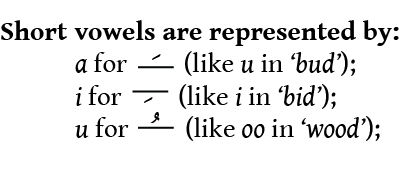
In this text, references to verses of the Holy Qur’ān have been footnoted and are given in the modern numerical system. In these references, we have counted Bismillāhir raḥmānir raḥīm as the first verse, except for Sūrah Taubah (that is Chapter 9 of the Holy Qur’ān). In these footnotes, the name of the Sūrah (chapter) has been mentioned, and then the numerical reference has been provided in brackets, whereas the first number refers to the Sūrah (chapter) and the second number refers to the Āyah (verse). The translation of verses of the Holy Qur’ān, Aḥādīth and other Arabic or Persian quotations have been rendered into English from the idiomatic Urdu translation of Ḥaḍrat Mirzā Bashīr Aḥmad Ṣāḥibra himself, as found in the original Urdu work.
The names of Islāmic months have been used in their original form. In the field of Islāmic history, there are two famous eras in the life of the Holy Prophetsa: prior to migration and after migration. Years spent by the Holy Prophetsa in Makkah, prior to the Migration are referred to as Nabawī years, and those following the migration are referred to as Hijrī years. In this text, Nabawī years have been clearly specified, for they have been followed by the term ‘Nabawī’ in italics. Hijrī years have been specified by the abbreviation A.H. (i.e., After Hijrah).
Throughout the course of this work, various Arabic terms and Islāmic phraseology have been transliterated and used in their original form. Wherever such terms are used in the text, a footnote has been provided upon the first instance of their appearance. A more elaborate explanation of such terms and phraseology has been given in the ‘Glossary of Terms’.
Please note that wherever reference is made to ‘Life of Mahomet[sa]’ written by Sir William Muir throughout this book, the Reprint of the 1984 Edition, published by Voice of India, New Delhi, has been quoted herein.
The following abbreviations have been used in this book; Readers are requested to recite the full salutations when reading the book:
SA: An abbreviation for Ṣallallāhu ‘alaihi wa sallam, meaning, “May peace and blessings of Allāh be upon him,” is written after the name of the Holy Prophet Muḥammadsa.
AS: An abbreviation for ‘Alaihissalām / ‘Alaihassalām, meaning, “May peace be upon him / her,” is written after the name of Prophets other than the Holy Prophet Muḥammadsa, and pious women prior to the era of the Holy Prophet Muḥammadsa.
RA: An abbreviation for Raḍiallāhu ‘anhu / ‘anhā / ‘anhum, meaning, “May Allāh be pleased with him/her/them,” is written after the names of Companions of the Holy Prophetsa and Companions of the Promised Messiahas.
RH: An abbreviation for Raḥimahullāh, meaning, “May Allāh have mercy upon him,” is written after the names of deceased pious Muslims who are not Companions.
In transliterating Arabic terms we have followed the following system adopted by the Royal Asiatic Society:
ا at the beginning of a word, pronounced as a, i, u, preceded by a very slight aspiration, like h in the English word ‘honour.’
ث th, pronounced like th in the English word ‘thing.’
ح ḥ, a guttural aspirate, stronger than h.
خ kh, pronounced like the Scotch ch in ‘loch.’
ذ dh, pronounced like the English th in ‘that.’
ص ṣ, strongly articulated s.
ض ḍ, similar to the English th in ‘this.’
ط ṭ, strongly articulated palatal t.
ظ ẓ, strongly articulated z.
ع ‘, a strong gutteral, the pronunciation of which must be learnt by the ear.
غ gh, a sound approached very nearly in the r ‘grasseye’ in French, and in the German r. It requires the muscles of the throat to be in the gargling position whilst pronouncing it.
ق q, a deep guttural k sound.
ء ’, a sort of catch in the voice.



Please note that in transliterated words the letter ‘e’ is to be pronounced as in ‘prey’ which rhymes with ‘day’; however the pronunciation is flat without the element of English diphthong. If in Urdu and Persian words ‘e’ is lengthened a bit more it is transliterated as ‘ei’ to be pronounced as ‘ei’ in ‘feign’ without the element of diphthong thus  is transliterated as ‘kei’. For the nasal sound of ‘n’ we have used the symbol ‘ń’. Thus, the Urdu word
is transliterated as ‘kei’. For the nasal sound of ‘n’ we have used the symbol ‘ń’. Thus, the Urdu word  would be transliterated as ‘meiń’.2 The consonants not included above have the same phonetic value as in the principal languages of Europe.
would be transliterated as ‘meiń’.2 The consonants not included above have the same phonetic value as in the principal languages of Europe.
For quotes straight commas (straight quotes) are used to differentiate them from the curved commas used in the system of transliteration, ‘ for ع, and ’ for ء . Commas as punctuation marks are used according to the normal usage. Similarly for apostrophe normal usage is followed.
1 In Arabic words like شیخ (Shaikh) there is an element of diphthong which is missing when the word is pronounced in Urdu.
2 These transliterations are not included in the system of transliteration by the Royal Asiatic Society (Publishers)